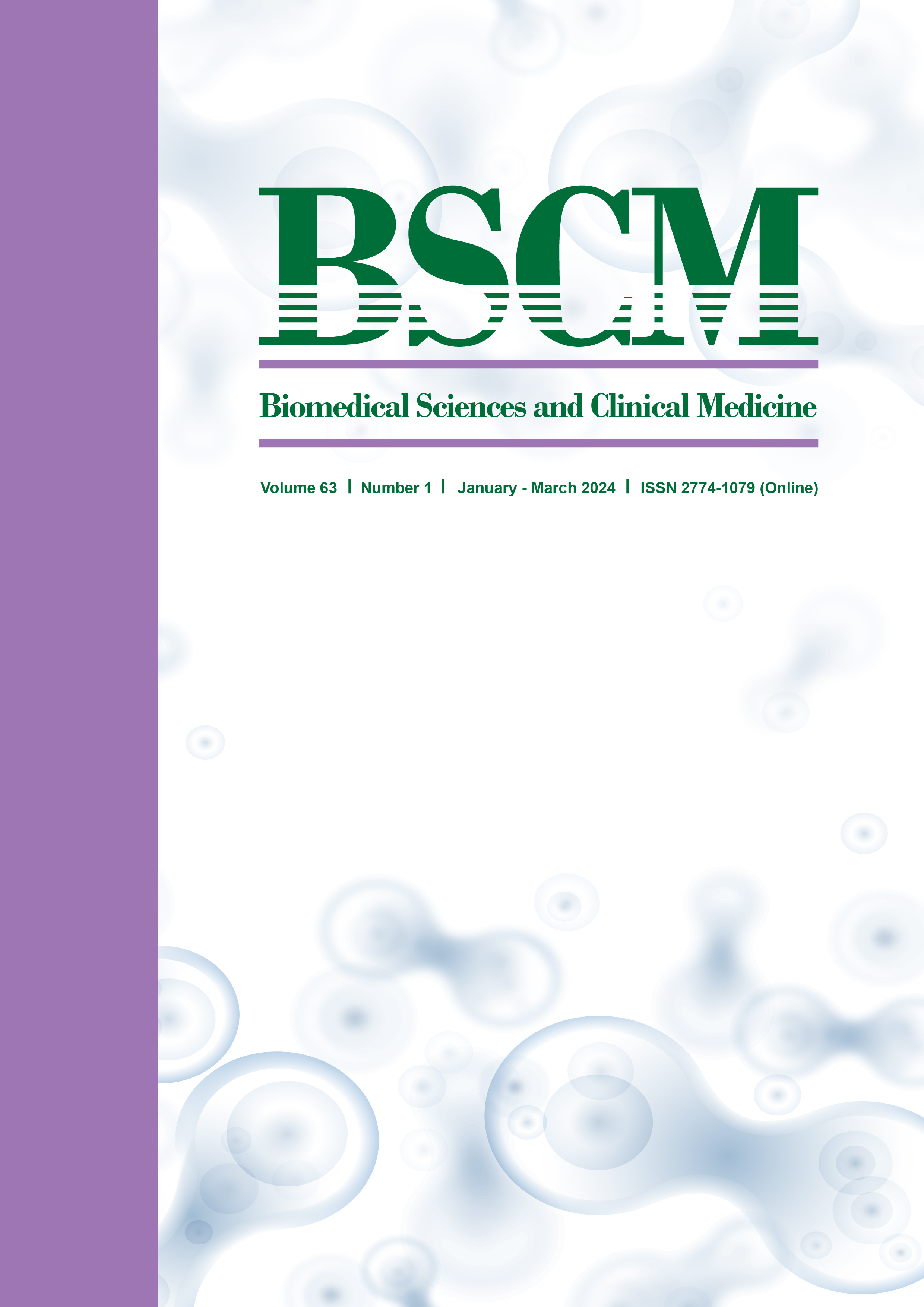A Method for Teaching “Safe Listening” Integrated with Early Clinical Exposure for Third-Year Medical Students
Main Article Content
บทคัดย่อ
OBJECTIVES The primary objective of this study is to describe a method for teaching “Safe Listening” integrated with early clinical exposure (ECE). Additionally, the study aims to assess preferred listening levels (PLLs), expected output levels, and classroom noise levels.
METHODS Retrospective cross-sectional study. After pre-activity instruction, medical students were grouped into classrooms. The noise level in each classroom was measured using a sound meter application both in quiet situations and during conversations while the medical students were listening to their personal listening devices (PLDs). A calibrated finger rub auditory screening test and a tuning fork test were conducted and PLLs were recorded. The students discussed the findings and rated their satisfaction with the process at the end of the activity.
RESULTS The average PLL of the 171 third-year medical students was 59.00 ± 7.38 dBA. The classroom noise level was 49.66 ± 8.45 dBA in quiet periods, and 77.51 ± 10.05 dBA during conversation and while listening to PLDs via earphones. In quiet periods, 97.65% of the students could hear finger rub in both ears. The average satisfaction score after the activity was 82.57 ± 13.14%.
CONCLUSIONS Practice with hearing tests and self-checks of PLLs introduced exposure to clinical learning together with awareness of safe listening. PLLs of medical students and satisfaction with the activity were in the favorable range.
Article Details

อนุญาตภายใต้เงื่อนไข Creative Commons Attribution 4.0 International License.
เอกสารอ้างอิง
Basukala A, Chaudhary K. Early clinical exposure in preclinical years of medical school. JNMA J Nepal Med Assoc. 2021;59:1072-4.
Tayade MC, Latti RG. Effectiveness of early clinical exposure in medical education: settings and scientific theories - review. J Educ Health Promot. 2021;10:117. PubMed PMID: 34084864.
Liu CI, Tang KP, Wang YC, Chiu CH. Impacts of early clinical exposure on undergraduate student professionalism a qualitative study. BMC Med Educ. 2022;22:435. PubMed PMID: 35668444.
Simmenroth A, Harding A, Vallersnes OM, Dowek A, Carelli F, Kiknadze N, Karppinen H. Early clinical exposure in undergraduate medical education: A questionnaire survey of 30 European countries. Med Teach. 2023;45:426-32.
World Health Organization. Safe listening devices and systems: a WHO-ITU standard. Geneva [Internet]. 2021 [cited August 3, 2023]. Available from: https://apps.who.int/iris/handle/10665/280085
World Health Organization and International Telecommunication Union. Be he@lthy, be mobile: a handbook on how to implement mSafeListening. Geneva [Internet]. 2022 [cited July 7, 2022]. Available from: https://www.who.int/publications/i/item/9789240044784
Laureyns M. Make Listening Safe. The Hearing Journal. 2022;75:6.
Williams W, Purnell J, Parnell J, Samuels S, Tsitsos C, Arcondoulis EJ, et al. The statistical distribution of expected noise level output from commonly available personal stereo players. Acoustics Australia. 2010;38:119-22.
Torres-Russotto D, Landau WM, Harding GW, Bohne BA, Sun K, Sinatra PM. Calibrated finger rub auditory screening test (CALFRAST). Neurology. 2009;72:1595-600.
Tavolacci MP, Delay J, Grigioni S, Dechelotte P, Ladner J. Changes and specificities in health behaviors among healthcare students over an 8-year period. PLoS One. 2018;13:e0194188. PubMed PMID: 29566003.
Lobelo F, Duperly J, Frank E. Physical activity habits of doctors and medical students influence their counselling practices. Br J Sports Med. 2009;43:89-92.
Tsouros AD, Dowding G, Thompson J, Dooris M. Health promoting universities: concept, experience and framework for action. Target 14 World Health Organization. Regional Office for Europe [Internet]. 1998 [cited October 8, 2022]. Available from: https://apps.who.int/iris/handle/10665/108095
AUN-Health Promotion Network Mahidol University. AUN Healthy University Framework [Internet]. 2017 [cited October 8, 2022]. Available from: https://mahidol.ac.th/temp/2019/04/Healthy-University-Framework.pdf
Henderson E, Testa MA, Hartnick C. Prevalence of noise-induced hearing-threshold shifts and hearing loss among US youths. Pediatrics. 2011;127:e39-46. PubMed PMID: 21187306
Portnuff CD. Reducing the risk of music-induced hearing loss from overuse of portable listening devices: understanding the problems and establishing strategies for improving awareness in adolescents. Adolesc Health Med Ther. 2016;7:27-35.
Paping DE, Vroegop JL, Koenraads SPC, le Clercq CMP, Goedegebure A, Baatenburg de Jong RJ, et al. A smartphone application to objectively monitor music listening habits in adolescents : Personal listening device usage and the accuracy of self-reported listening
habits. J Otolaryngol Head Neck Surg. 2021;50:11. PubMed PMID: 33588927.
Paping DE, Vroegop JL, Geleijnse G, le Clercq CMP, Koenraads SPC, van der Schroeff MP. Objective Measurement of Listening Device Use and Its Relation to Hearing Acuity. Otolaryngol Head Neck Surg. 2022;166:515-22.
Lee HJ, Jeong IS. Personal listening device use habits, listening belief, and perceived change in hearing among adolescents. Asian Nurs Res (Korean Soc Nurs Sci). 2021;15:113-20.
Gilliver M, Nguyen J, Beach EF, Barr C. Personal listening devices in australia: patterns of use and levels of risk. Semin Hear. 2017;38:282-97.
Portnuff CD, Fligor BJ, Arehart KH. Teenage use of portable listening devices: a hazard to hearing? J Am Acad Audiol. 2011;22:663-77.
Hoshina T, Fujiyama D, Koike T, Ikeda K. Effects of an active noise control technology applied to earphones on preferred listening levels in noisy environments. J Audiol Otol. 2022;26:122-9.
World Health Organization. WHO ear and hearing survey handbook. Geneva [Internet]. 2020 [cited July 7, 2022]. Available from: https://www.who.int/publications/i/item/9789240000506
Kardous CA, Shaw PB. Evaluation of smartphone sound measurement applications. J Acoust Soc Am. 2014;135:EL186-92. PubMed PMID: 25236152


